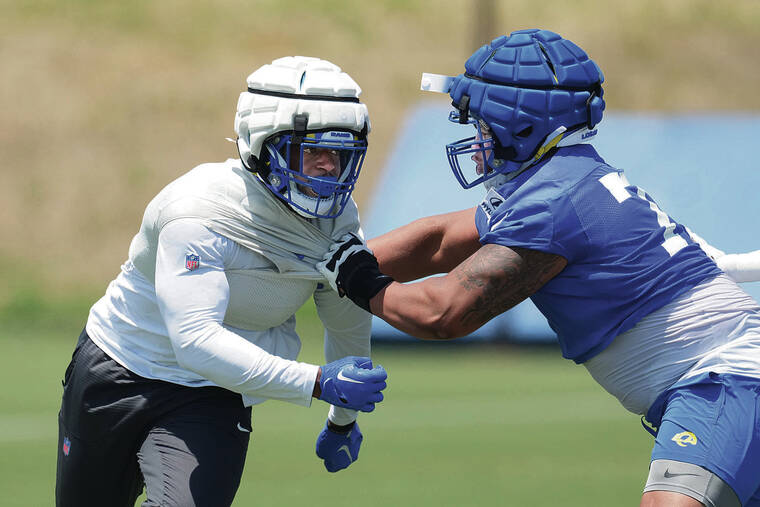When I see or hear about a concussion in football, a conversation in the 1990s with the late, great Russ Francis often comes to mind.
“You know, they do have safer helmets,” said Francis, who was sports director at KGMB at the time.
I did not know and asked him to please tell me more.
The league and most of the players didn’t like the new, safer helmets because they didn’t look cool enough, Francis said.
I probably shook my head and muttered something about player safety being most important, and the discussion moved on to skydiving or pro wrestling, two of Francis’ many other interests.
The only things I really remember from that casual conversation are those few words about helmets. They’ve popped into my head many times since, including last week when Tua Tagovailoa sustained another scary head injury.
But I never learned more about what Francis was specifically referring to until Tuesday.
Nathan Murata, dean of the University of Hawaii’s College of Education, educated me during a phone interview.
Murata, who is also a driving force with the Hawaii Concussion Awareness &Management Program, mentioned Mark Kelso, whom I did remember as a hard-hitting safety with the Buffalo Bills. Murata told me that Kelso’s nickname became The Great Gazoo, and why.
The Great Gazoo was an incongruous character on “The Flintstones,” which is the GOAT of cartoons about prehistoric people. Gazoo was a well-meaning but strange and irritating little alien, with a weird-looking, oversized helmet on his green head. The Great Gazoo did not look, or act, cool.
That didn’t bother Kelso.
“Kelso suffered from four concussions from 1988-1989,” according to profootballhof.com. “Bills trainer Adam Abramoski became concerned and suggested a padded helmet attachment called ‘Pro Cap’ for the 1990 season.”
The covering over his regular helmet extended his career, said Kelso, who started in the Bills’ four Super Bowl appearances from 1990 to 1993.
Only two other players, Steve Wallace (49ers) and Randy Dixon (Colts), are known to have joined him in using the Pro Cap, because “most players didn’t like the look of it and there were concerns that the weight of the helmet could cause neck injuries,” according to the same profootballhof.com article.
Murata brought up Kelso and Pro Cap because I asked him about Guardian caps, which are allowed in regular-season NFL games for the first time after two years of required training camp and preseason trials for certain position groups.
Colts tight end Kylen Granson is among six NFL players who have worn the optional caps over their helmets in the first two weeks of the regular season.
“At one point people thought seatbelts were (expletive) stupid,” Granson said in an article in The Athletic. “Why wouldn’t I (wear it)? Just because it looks silly? I feel like health and safety is more important than aesthetics.”
Guardian caps are made of soft shell material that absorbs so much contact that there were 50 percent fewer concussions when players used them in training camp and preseason games, according to an NFL spokesman.
But some independent studies have indicated otherwise, and even Guardian, the company that produces the caps, warns that the product is not proven to prevent all concussions.
Murata said he is hopeful about Guardian caps but needs more information.
“The data hasn’t been made public yet, so some, like myself, are skeptical. It’s not that we don’t believe it, it’s just that as scientists we want to see the data,” Murata said. “The concern is that when you put something external on the helmet, the question becomes if you compromise the integrity of the helmet in some way. At HCAMP we’re very interested in learning more about the Guardian caps.”
HCAMP’s research includes the recently completed HuTT808 project, which teaches “taking the helmet out of contact” to high school coaches and players. Murata said the pilot program was successful, and he hopes it will expand statewide.
Like Tagovailoa, Murata played high school football at Saint Louis School.
“The last few days there’s been a lot of talk about my fellow Crusader,” Murata said. “At that moment in time, you’re not thinking about protection, but about doing what you need to do. It was painful to see. It showed that concussions are not necessarily a result of head-to-head contact, as that was head-to-chest.”

